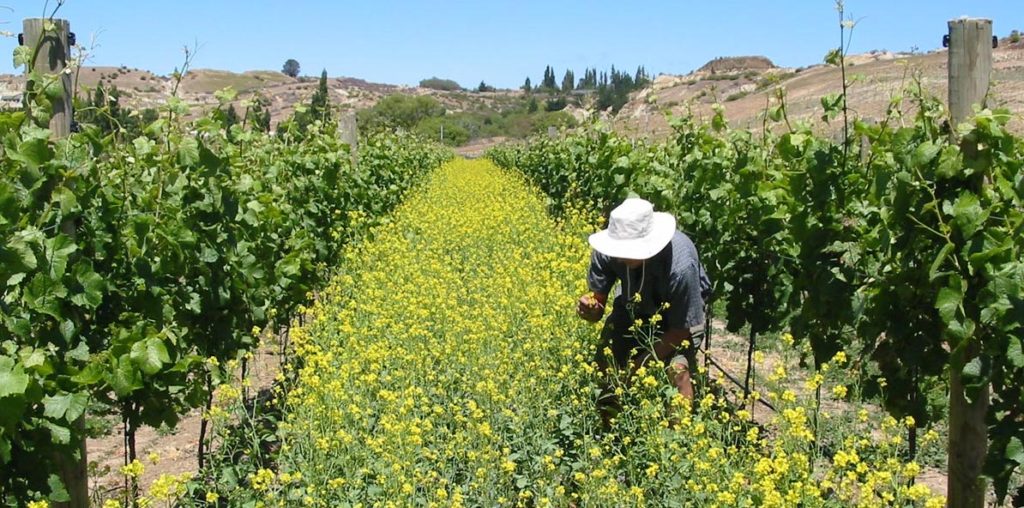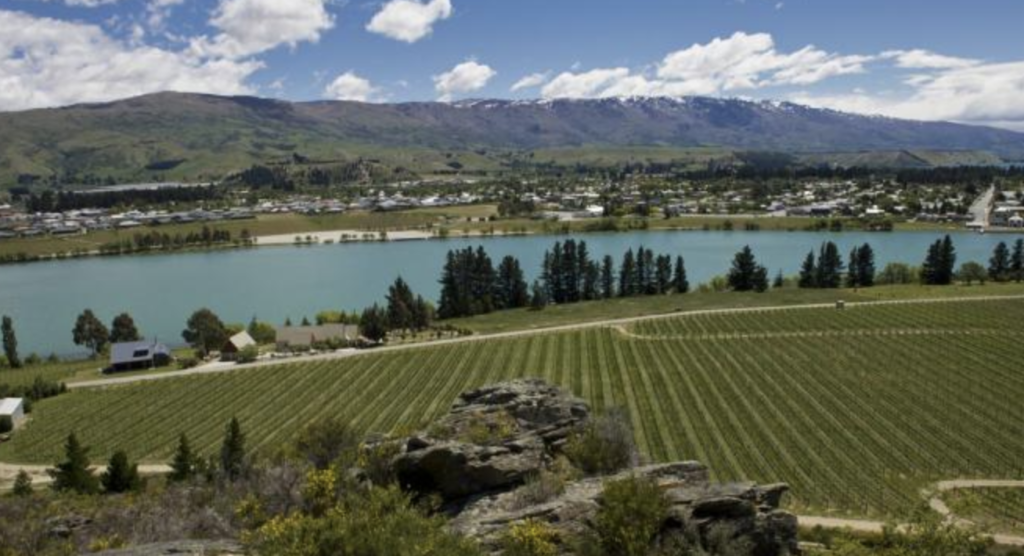Felton Road is one of the better known names in New Zealand wine. A true trailblazer as it was the first winery in Bannockburn, Felton Road helped put Bannockburn as a wine region on the map. It stormed onto the scene with its first Pinot Noir vintage in 1997, winning trophies and rave reviews, and remains a firm fixture on the list of top-scoring Pinot Noirs in the New World and one of New Zealand’s most prized Pinots.
Bannockburn as a wine region of 325 hectares produces less than a fifth of the wine made in Central Otago (which has around 2000 hectares) but has one of the most organized wine routes and is one of the better known sub-regions, with several wineries back to back along the roads. That, however, doesn’t mean to say that it is homogenous as a wine region: “The soils are incredibly variable throughout Bannockburn,” explains Blair. “Just along the 3 km of Felton Road we have 10 different soil types!”
These different soils are what inspired Felton Road to vinify by block, and this has resulted in some of their best known wines, which are produced from single lots in order to reflect the particularity of the terroir. Blair uses Pinot Noir to express the site difference but also the terroir-transparent varieties Chardonnay (which he sees as “extremely underrepresented in Central Otago”) and Riesling.
I interviewed Blair on a rather windy day in the Bannockburn vineyard about why Pinot Noir works so well in Central Otago and his thoughts on the future GIs of New Zealand, including that of Bannockburn:
Bannockburn & Central Otago terroir: Blair Walter interview from Felton Road
What attracted you originally to come to Central Otago and make Pinot in the late 90s, or mid 90s actually?
I studied at Lincoln University in Canterbury in the late 80s, and I finished in 1990. At that time, the first wine from Central Otago had only just come out. It was a 1987 vintage. And there was very tiny quantities, there really wasn’t very much about. I’d heard of it and only tasted a couple of wines. But there seemed to be something about the early wines that I did taste that showed a lot of potential. There was a real spark in the wines. And in particular, the early wines from Rippon in 1991, 1992, were Pinot Noirs that I thought were of incredible quality and had enormous potential. So, those were instrumental wines for me.
What is the affinity that Central Otago has for Pinot Noir? Why is it a great Pinot land?
I think for Pinot Noir you really need to have a cool climate for it to excel and we definitely have that here in Central Otago. The problem with a lot of cool climate areas when you go to find them is that they can tend to start to become wet climates. And particularly in the autumn when you are waiting for that last degree of ripeness to occur.
In Central Otago we are the driest part of New Zealand. We have only 350mm of rain annually. And when we do get rain it is always associated with winds. Being a small island in the middle of the southern ocean, it’s always very windy here. So our threat of disease is extremely low. So we have very clean fruit that ripens in a cool climate. Even after a cool summer we can still harvest perfectly ripe fruit, we just wait a little bit longer and we will eventually get the ripeness.
How would you characterize Central Otago Pinot in the glass?
Our Pinots are definitely influenced by the young vines at the moment. The oldest vines in the region are barely more than 25 years old, and so that is a component that we are working through. And we are starting to see much greater improvements from the older vines. They tend to be quite fruity but, again, as the vines are ageing the fruit is a little more suppressed and we are starting to see more complexities coming through.
There’s always good acidity from the cool climate and the cool nighttime temperatures that we have. And the dark cherry, black fruit spectrum is quite common. In the warmer temperatures we tend to get more of the red fruit spectrum. And I think the fruit tannin is relatively moderate so the wines have a suppleness and an elegance to them.
Felton Road is very well known for putting Bannockburn on the map as a sub-region of Central Otago. Can you explain to us, what is the Bannockburn wine region about and what differentiates it from the rest of Central Otago?
In Central Otago we have seven sub-regions that make up the greater Central Otago region. And it’s quite a large area. We have a series of valleys and basins. For example, from Bannockburn to the Wanaka area, you have to travel 55km but over a 2000m mountain range. We are at, our elevations are at 200 to 300m here. So the sub-regions are really quite distinct.
I think its really important in the future that we identify these sub-regions and get them labelled and mapped and GIs applied for. To give us that protection. The difference between them, you are going to get different climatic effects in these basins. The soils are different. We also have to say that we’ve got a lot of variation within the sub-regions as well so you can’t just generalize about the soils.
How many different soil types do you find within Bannockburn wine region?
Along the length of Felton Road, which is only 3km, we have up to 10 different soil types. From pure clay to pure sand, to alluvial gravel, rounded pebbles, to angular schist gravel, heavy silts. So the soils can be very diverse and very complex.
You are biodynamic wine producer as well. Can you tell us what you think is the opportunity for producing biodynamic or organic wines here?
We produce, well have done since 2002, our vineyards under organics and biodynamics. The dry climate and low rainfall are very conducive to it. We have very low disease pressure, so it just makes sense to farm organically and biodynamically.
Do you see a trend in New Zealand going towards that direction?
Yes, definitely. I mean in an informal survey that we did in Central Otago, we found that just on 25% of the vineyards here are now being farmed organically or biodynamically. Now that’s pretty significant for a wine region to have that high a percentage. I think overall nationally in New Zealand it’s around 7% and every year there are more and more vineyards converting when they see the benefits from the producers that have been doing it some time.

Felton Road’s biodynamic cover crop (FeltonRoad.com)
Felton Road wine tasting notes
Felton Road Bannockburn 2017
This is Felton Road’s main Pinot Noir and it is a blend from all four of the winery’s Bannockburn vineyards. With dark fruit and spice on the nose, this wine has quite peppery tannins with great length and a crunchy feel. An attractive Pinot Noir that gives you a well-rounded option for dinner.
Felton Road Cornish Point Pinot Noir 2017

Felton Road’s Cornish Point vineyard (FeltonRoad.com)
Overlooking the river (just meters away from the glacial river), Cornish Point produces their softest Pinot Noir as the temperatures are moderated by the nearby river and the windblown loess on alluvial gravel vineyard helps soften the acidity and fruit expression. This wine has nice perfume on the nose with bright red fruit and floral aromas and a freshness on the palate and smooth tannins. This is the fruitier, softer and more inviting style of the single block Pinot Noirs.
Felton Road Block 3 Pinot Noir 2017
This is the block that Blair has isolated as distinct ever since his first vintage in 1997 and is part of the schist-based Elms vineyard. The wine is distinctive, carrying some weight on the palate but with a fine texture on the finish and quite silky tannins. Dark fruit, dried winter herbs and spice.
Felton Road Bannockburn 2017 Chardonnay
This is the estate Chardonnay with a blend of 90% Elms vineyard and 10% Cornish Point, and it includes 25 year-old vines and also 12 year-old vines. With just over a year in barrel and just under a year on the lees, there’s some opulence to this wine. However it also has lots of bright stone fruit notes with fresh blossom. It is a lovely style of Chardonnay – balanced, appealing, with good acidity and ultimately very inviting.
Felton Road Block 2 Chardonnay, 2016
This block comes from a vineyard with schist gravels and the poorer soils are evident in the leaner style of the wine. The nose is driven by mineral notes and delicacy, while the palate reveals some fruit but is mainly focused on texture, drive and a long, chalky finish. Stylish Chardonnay.
Felton Road Dry Riesling 2017
This Riesling all comes from Block 2, on schist gravel. It is their entry level Riesling, which is bone dry (rather than the off-dry style of the Bannockburn Riesling). It has a really vibrant nose with bright notes of citrus, lime and a little bit of trademark kerosene creeping in. A great food wine.
Felton Road Riesling Block 1 2017
This is definitely a geekier Riesling with a much more mineral-driven nose, although some white apricot notes add a little warmth. The acidity is striking but the touch of residual sugar helps balance it out. A Riesling worth ageing. It comes from north-facing slopes on the heavier soils.
Read more on Central Otago wines and wine producers:
- The anomaly that is Central Otago
- Central Otago then and now: Grant Taylor, Valli Wines
- Prophesying a lighter style of Pinot Noir: Paul Pujol, Prophet’s Rock
- Central Otago wine region guide: Fast Facts & Terroir Essentials

